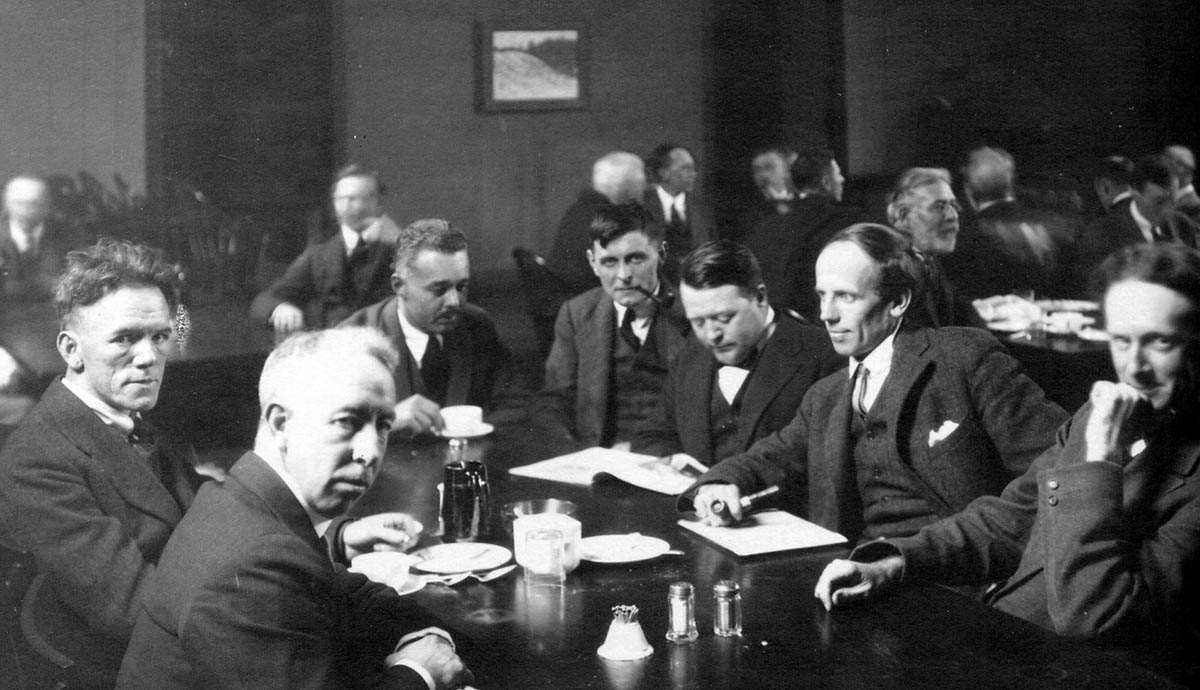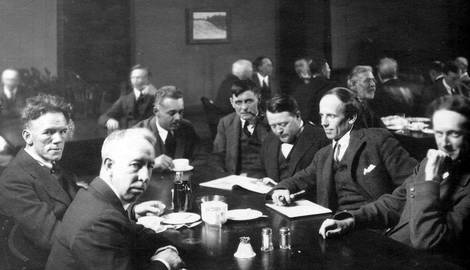
By the late 19th century, most European countries had established renowned national schools of art. Canadian artists were finding it difficult to stand out. The Group of Seven wasn’t the first band of artists to explore the idea of Canadian Nationalism, but they were the most successful.
Group Of Seven Artists Meet In Toronto

In 1906, JEH McDonald was promoted to the position of Head Designer at Grip Ltd. In Toronto. Through the years, some of the best Canadian artists of the time came to work for the firm. Franklin Carmichael, Frederick Varley, Arthur Lismer, and Frank Johnston, all of them worked with MacDonald. They made up the earliest configuration of the Group of Seven.
Lismer and MacDonald met AY Jackson and Lawren Harris at the Arts and Letters Club in Toronto in 1911. It was a private club for men seeking creative pursuits. Eventually, it became a place to share ideas and eat lunch. Tom Thomson could be found hanging out at the club most afternoons. He wasn’t a member. Looks like the Club could bend its rules, just not for women until 1985.
Inspiration Lies In The North

Lawren Harris and JEH MacDonald naturally gravitated towards each other. It was probably their shared interest in Theosophy that did the trick. Harris had all these interesting ideas and MacDonald was very open to hearing about them. In 1913, Harris took MacDonald to an exhibition of Scandinavian art. The show got them thinking about the potential of Canadian Art, what it could be. They found their answer in the wild country.
At the time, Canada’s population wasn’t something to write home about. The outskirts of the cities were practically empty. Here, they found Canada, an untouched paradise, home. Harris and MacDonald would arrange trips for the Group to be acquainted with the countryside. They started visiting Algonquin Park where Tom Thomson would spend his last few years. Eventually, they made it up north to the Algoma Mountains. The Group of Seven were forced to seek their Canada out. Travel is what made this movement work.
A Sanctuary for Canadian Artists

Lawren Harris was heir to the Massey-Harris fortune. He became one of the primary sponsors for the Group. He would fund sketching trips, and even offer painting supplies for peers who needed it. His biggest legacy was the space he built with Dr. James MacCallum at Rosedale ravine. It was an ambitious enterprise, designed to be a low rent apartment complex with built-in studios for struggling artists.
AY Jackson, the traveling painter from Montreal, was one of the first occupants of the Studio building. Tom Thomson and Franklin Carmichael followed soon after. The goal of the space was to give artists a place to practice, socialize, and live. The monthly rent for a studio at the time was only $22. Six artists out of the Group of Seven are buried on the premises.
Who’s Tom Thomson?

In an alternate universe, Tom Thomson would’ve been the eighth member of the Group. He disappeared off the face of the earth in 1917. They wouldn’t come up with a name till 1919. He never got to exhibit with the seven, but he taught his peers all he knew about the Northern Frontier.
Thomson was pretty much the 1900s version of Alexander Supertramp. He hated the pretense of the city, loved the outdoors, and preferred being on his own. Thomson met little creative success during his lifetime. He was so poor that he couldn’t even afford to rent his subsidized studio. Luckily, Dr. MacCallum, Thomson’s fondest patron, loved him too much to kick him out. He built Thomson a shed behind the studio building, charging him a dollar a month instead.

He met the Group of Seven in Toronto while he was working at Grip Ltd. After the Studio Building was built Tom moved in. He quit his job and took up a job in Algonquin Park as a Ranger. He would spend his summers painting in the Park, and in the winters he would return to finish the paintings in his shed.
In 1917 he mysteriously disappeared from Algonquin Park. Some theories suggest he drowned, while others suggest he was killed. Thomson’s loss was pretty hard on the Group. AY Jackson called dibs on Thomson’s easel to keep his memory alive.
Setting Up An Exhibition Of Canadian Art

A few years after Thomson’s death, the group finally got around to exhibiting their work. On 7 May 1920, the Group of Seven held its first exhibition at the Art Gallery of Ontario. With 120 paintings lining the walls of the gallery, they hoped the Canadian Public was ready to recognize Canadian art.
The exhibition wasn’t a commercial success. They sold as many paintings as the fingers on your right hand, precisely 5. It wasn’t what they were going for, but they were making history anyhow. Over 2000 people attended the show, a pretty good turn-out back then.
The Group of Seven would hold 8 exhibitions together. They would later feature artists from all over the country in these shows.
Artists Come and Artists Go

The first painter to quit the group was Frank Johnston. He left for reasons that have more to do with ambition rather than disagreements within the faction. In 1921, Johnston got a new position at the Winnipeg School of Art. His solo career was awaiting and he made more paintings than the others. He handed in his resignation in 1924.
Two years later they found a replacement for Johnston. AJ Casson was drafted into the team. He was the youngest of them all, just about 28. Casson met Franklin Carmichael in 1919. They were employed by Rous and Mann at the time. Carmichael introduced him to the group and they pretty much hit it off right away. Seven years later, he was in.

Edwin Holgate joined the group in 1930. He had been busy setting up the Montreal art scene before that. AY Jackson and he were good friends. They gave each other company on several painting expeditions together. Ultimately, Jackson introduced him to the rest of the artists. Soon enough, he was part of the team.
In 1932, Lionel LeMoine Fitzgerald was granted membership to the club. He wasn’t exactly a team player, preferring to work alone. He was also the only painter in the group who came all the way from Manitoba. We can’t blame him for the distance.
Capturing Canada Through Different Mediums

Their muse, however, had them running all over the countryside. They needed to be mobile, and they needed all their gear to fit into a haversack. Tom Thomson sometimes used cardboard and oil paints on his canoe trips to Algonquin Park.
Carmichael made a lot of watercolor paintings, sometimes switching to pastel, and even oil every once in a while. Casson followed in his footsteps, proving an affinity for watercolors. Harris thought himself a better oil painter but still dabbled with watercolors. Johnston used Tempera instead of oil paint.
The Group of Seven were exploring modernism through a variety of lenses. It isn’t surprising that they would decide to work with such diverse media. Portability was a major factor, and oil undeniably failed the criteria. Most artists would take their sketches back to their studio and revisit the painting with oil on a sturdier mount.
The Rise of Canadian Nationalism in Art

The Group of artists stuck together for over a decade. Through the years they became aggressive advocates of Nationalism in Canada. Art Clubs throughout Toronto were busy deliberating over strategies that could help them achieve the same. The Group of Seven found each other in the thick of this discourse.
Lawren Harris was the most influential ideologue of the group. His idea of nationalism had a lot to do with spiritualism and theosophy. Since it was the early 1900s, it isn’t surprising that his ideas were slightly racist. It was believed that Canada was, more or less, Aryan territory. As material things started dominating their daily lives, they started becoming corrupt. Their connection to the spiritual nature of the land was severed. According to Harris, a restored relationship with the North could make Canadians spiritual.
The first World War had given Canadians a reason to rally together. The Group of Seven wanted to give Canadians a tangible legacy. Art circles in Canada were still pretty hung up on the European aesthetic. The Group had a tough time selling their paintings. A critic once called them the Hot Mush School. It wasn’t a compliment. Despite all the odds, it was these artists that proposed a way forward.
The Group of Seven Artists Disbands

After fourteen years of officially fronting the Nationalist cause as the Group of Seven, the artists decided to go their separate ways. They believed they had finally gotten through to the Canadian people. They held their last exhibition in 1931.
JEH MacDonald died in 1932. A year later, the Group of Seven was dissolved to make way for the Canadian Group of Painters. The new group included artists from all over Canada, not just Toronto. The Group had successfully established an official Canadian Art practice. Mission accomplished.





